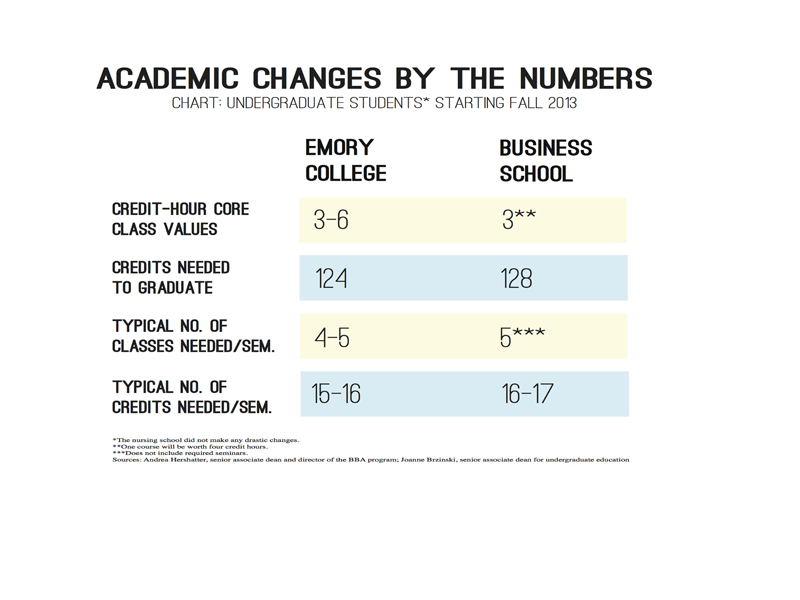Several academic changes regarding credit hours, graduation requirements and class timeslots have gone into effect across the University this semester.
In the College, credit hours for courses are now determined based on the amount of time a class meets each week, rather than designating most classes with four credit hours as was done in the past. Classes with an extra component – such as a lab – are worth more credits than the “standard” three-credit courses.
At the Goizueta Business School, almost all core classes are worth three hours, effective last semester. As of this fall, all BBA electives and prerequisites are also worth three hours, rather than four, except for a course that meets for extra hours and carries four hours.
With the credit-hour changes taking effect, the College has officially lowered its graduation requirement to 124 hours from 128, and the B-School to 128 from 138.
Laney Graduate School has also changed its credit-hour system, implementing a “strict 1:1 match between time in class and credit recorded,” said Ulf Nilsson, the assistant dean of operations at the school. Beforehand, course credits varied, but the standard, full-time course was four credits, she added.
The graduation requirements with different Laney Graduate School programs vary but will be altered to reflect the credit-hour adjustments, Nilsson said.
In addition to credit-hour changes, the College has altered the timeslots during which classes are offered. Specifically, 75-minute courses that meet twice a week are now also being offered on Mondays and Wednesdays, rather than primarily on Tuesdays and Thursdays. These 75-minute classes now run from 8:30 a.m. through 6:45 p.m.
Fifty-minute classes that meet three days a week are now also being offered on Monday, Tuesday and Thursday, not just Monday, Wednesday and Friday.
These 50-minute classes start at 8 a.m., rather than 8:30 a.m., and go through 5:50 p.m.
Sophomores, juniors and seniors are being grandfathered into the new credit-hour system and graduation requirement.
So, the number of credits they have received so far will stay the same, but they will adhere to the new policies moving forward.
The University first decided to make the credit-hour changes as part of Emory’s reaccreditation by the Southern Association of Schools and Colleges (SACS), which will take effect next year.
SACS must reaccredit Emory every 10 years for the school to qualify for federal funds.
During SACS’ last reaccreditation review, it questioned the disparities between the number of credit hours offered and the amount of time a class met each week, the Wheel reported last spring.
In the past few years, the Department of Education also decided to require an institution to abide by the Carnegie Unit System – where hours offered equal class meeting time – to be accredited, according to the Wheel article.
Senior Associate Dean for Undergraduate Education Joanne Brzinski said the new credit-hour system is proceeding “very smoothly.”
“We’ve had fewer problems than we’ve anticipated,” she said. “For students, this is a way to readjust their way of thinking about their schedule – focusing on the credit hours rather than the number of courses.”
The B-School’s Senior Associate Dean and Director of the BBA Program Andrea Hershatter said that from an administrative standpoint, the implementation of the changes is going well. She explained that the B-School has been preparing for the credit-hour change for more than a year.
She added that she hopes students will “enjoy the additional room in their schedule” to take more electives.
The largest obstacle in the process, Hershatter said, was devising a program that would allow accounting students to earn 30 hours of accountancy and the 150 academic hours they need to qualify for the Certified Public Accountant exam.
As a result, the B-School is attempting to create a new BBA/Masters of Accounting combined degree that is currently pending formal approval from the University and faculty.
“The challenges to the credit-hour change lie in working through the transition,” Hershatter said, noting that by the time incoming freshmen are BBA students in two years, five three-credit hours a semester will be the norm.
In the College, freshmen are being encouraged to enroll in an average of 16 to 18 credit hours, which includes their HLTH 100 and PACE requirements, Brzinski said.
Along with the graduation requirement change, the College is also requiring students to take at least 32 courses in order to graduate, rather than 28, regardless of the number of credits they achieve. In an update on the University’s webpage detailing the academic changes, the University clarified that approved AP, IB and transfer courses will count toward the 32-course requirement.
The B-School has also implemented a requirement for the minimum number of classes a student needs to take: eight classes and three five-hour seminars, as well as a minimum of 10 electives.
Meanwhile, the University reviewed each department’s request for each course’s credit value primarily during the spring. The University’s Educational Policy Committee, which reviews courses that departments submit, sent out guidelines to departments with general ranges of how many hours a major or minor should require.
The University also launched its webpage detailing the academic changes at the beginning of last semester. The site “outlines some of the biggest questions we think students will have,” and the University is continuing to update the page, Steve Savage, communications specialist for the Office for Undergraduate Education, wrote in a Jan. 28 College-wide email.
– By Jordan Friedman
The Emory Wheel was founded in 1919 and is currently the only independent, student-run newspaper of Emory University. The Wheel publishes weekly on Wednesdays during the academic year, except during University holidays and scheduled publication intermissions.
The Wheel is financially and editorially independent from the University. All of its content is generated by the Wheel’s more than 100 student staff members and contributing writers, and its printing costs are covered by profits from self-generated advertising sales.





Hello! I could have sworn I’ve visited your blog before but after browsing
through a few of the posts I realized it’s new to me.
Anyways, I’m certainly happy I discovered it and I’ll be
book-marking it and checking back frequently!
Does your website have a contact page? I’m having problems
locating it but, I’d like to send you an email. I’ve got some
creative ideas for your blog you might be interested in hearing.
Either way, great blog and I look forward to
seeing it grow over time.
Sublime lecture, je vous en remercie !!!
I all the time emailed this webpage post page to all my contacts, as if like to read
it then my contacts will too.
The window of diplomacy will not stay open forever, Kerry told reporters.
[url=http://airjordanss.over-blog.com/2014/01/air-jordan-11-black-gamma-blue-freshly-baked.html]airjordanss.over-blog.com/2014/01/air-jordan-11-black-gamma-blue-freshly-baked.html[/url]
I have been browsing on-line greater than 3
hours nowadays, yet I never found any fascinating article like
yours. It’s pretty worth sufficient for me. In my view, if all webmasters and bloggers made excellent content as you did, the web will likely be a lot more helpful than ever before.
I love what you guys are usually up too. This kind of clever
work and exposure! Keep up the very good works guys I’ve included you guys to my personal blogroll.
I’m really inspired together with your writing
abilities as well as with the structure for your blog.
Is that this a paid subject matter or did you modify
it yourself? Anyway keep up the excellent quality writing,
it is uncommon to look a nice blog like this one
nowadays..
Does your website have a contact page? I’m having a tough time locating it but, I’d like to send you an e-mail.
I’ve got some creative ideas for your blog you might
be interested in hearing. Either way, great website and I look forward to
seeing it develop over time.
You made some really good points there. I checked on the net for more info about the issue and found
most people will go along with your views on this website.
J en veux plus !!! par ici je vous place dans mes preferences, a bientot.
Its like you read my mind! You seem to understand so much about
this, such as you wrote the ebook in it or something.
I think that you simply could do with a few p.c. to pressure the message home a bit, but instead of that, that is great blog.
A great read. I will definitely be back.